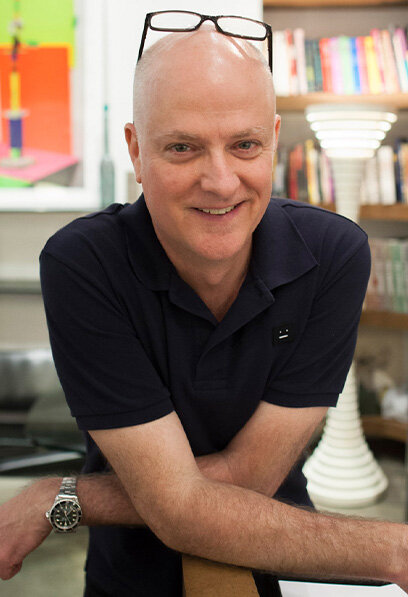386
386
Finland/USA, c. 1945
glazed stoneware 4 h × 2⅝ dia in (10 × 7 cm)
glazed stoneware 4 h × 2⅝ dia in (10 × 7 cm)
estimate: $2,000–3,000
follow artist
Incised signature to underside 'MG'.
This work will ship from Chicago, Illinois.

If asked to select one word to describe Patrick, I would resist and pick two. The first would be curiosity — a fundamental essential, to stimulate inquiry and rigour in all things, both great and small, of any era or region, type or surface. Even the most fleeting survey of this selection for sale is a celebration of innovation and of inspiration — an unerring eye for the unusually exceptional, or perhaps the exceptionally unusual. The chances are, that these are indeed discoveries that you have not yet realised that you needed to make.
Mentor, would be my second word. If artefacts and objects articulate visual, cultural and historic language, then the fluency of skillful mentorship — to guide, nurture, describe and explain — releases the eloquence of murmuring histories. In this capacity Patrick is that most earnest and sincere of excellent narrators. If ever I had friends, clients or colleagues visiting New York looking for unusual inspiration, there was always the certainty that Patrick’s venues would offer them a glimpse of the hitherto unseen or the unusually seductive, always with the reassurance of the most fascinating story waiting to be told.
Mentorship and curiosity, when balanced in equal measure, reveal the precious alchemy of a curator. And it is the duty of the mature curator to discern and detect, to cultivate change, and from there to pioneer, and to share. Innovation is never static, and the Present is already the Future. Fresh dialogs evolve, energies to be nurtured, opportunities to be guided. Renewed and re-orientated, Patrick’s decision to exchange his bricks-and-mortar Tribeca gallery for a new interactive Brooklyn space aligns him towards a new inquisitive future as supportive benefactor, interlocutor and mentor to a fresh yield of talented creators — those established and those rising — and the quest for discovery rejuvenates.
— Simon Andrews
andrewsartadvisory.com
Maija Grotell 1899–1973
Finnish-American ceramic artist and teacher Maija Grotell was born in Helsinki in 1899. She trained at the University of Art & Design Helsinki and worked as a textile designer for the Finnish National Museum while studying. With employment scarce in Finland in the 1920s, Grotell moved to New York City in 1927.
After only three days, Grotell found work and spent the following summer at Alfred University in Western New York under the supervision of Charles Fergus Binns. While Binns taught in a formal, constructive manner, Grotell preferred to learn directly on the potter's wheel. During the interwar period, wheel-thrown ceramics were not yet common in the United States. American pottery making favored slip casting, coiling, and slab building. Yet Grotell's skill at the potter's wheel was undeniable and she distinguished herself as an instructor in New York City in the 1930s.
In 1938, Grotell was hired as head of the ceramics program at Cranbrook Academy of Art in Bloomfield Hills, Michigan, filling a position previously occupied by Waylande Gregory. Grotell was initially hesitant to accept the job because she feared her independence might be compromised and credit for her work given to male colleagues. However, over the next three decades, through her experiments with high-fire glazes and stoneware clay forms, Grotell proved herself a dedicated, innovative ceramicist and a passionate educator. She would often teach all day and then work in the pottery studio all night. Eventually, this tireless work ethic would take its toll, leading to chronic muscle tightness in the 1960s. Grotell ultimately passed away in 1973 in Pontiac, Michigan.
Grotell's legacy as an important ceramic artist is evident in the many fine geometric and figural works that remain. Examples are held in various private collections and by notable institutions such as the Metropolitan Museum of Art in New York City, the Museum of Fine Arts, Boston, the Art Institute of Chicago, the Cranbrook Art Museum, and elsewhere. Furthermore, Grotell is often referred to as "the mother of American ceramics" since she made Cranbrook's ceramics department a leader in the field and trained prominent artists like Richard De Vore, Marie Woo, Jan Sultz, John Parker Glick, Howard Kottler, and Toshiko Takaezu.
Auction Results Maija Grotell